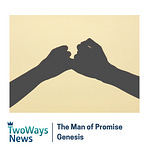The painful truth this week is that this is a rather bitsy Payneful Truth; a series of short bites rather than a single vaguely coherent article.
The main reason for this is that I’m in the process of putting together some fairly major changes to The Payneful Truth that (God willing) I’ll be announcing in the next week or two. Don’t be alarmed: they are good and exciting developments! But organizing and sorting out the changes is taking some work, and that means less available clear air for … actually writing stuff.
I will say more soon as I can, and as partners and subscribers you will be the first to know. But it means that this week, it’s bits and pieces, particularly picking up on some of your recent correspondence.
First off, an encouraging email from Josh Dickinson in response to my piece about the value and importance of reading Christian books. He writes about how he and a friend addressed precisely this issue:
You asked for thoughts on how we might encourage reading. As I was previously an impoverished but now fairly prolific reader, I thought I might share the fun activity that changed me.
A few years ago we were reading a book as part of a small training team, when one mate and I were convicted of our poor reading. I had done an eight-week weight loss challenge recently at my gym, so to kick start reading we set ourselves a similar challenge. We challenged each other to read eight Christian books in eight weeks. The rules were simple: they could be any theological books you wanted to read (and each person could pick different books), and by the last week you had to have read all the books—but you didn’t have to read one book per week (making it easier to read bigger books). Since completing this challenge with my friend we haven't stopped, and God has grown us so wonderfully through reading.
So there you go—the 8-in-8 reading challenge. Or you might make it 10-in-10, or even a less ambitious 6-in-12. And while it might mean a bit less TV or social media or Youtube scrolling, you just might ignite a taste for spiritually nourishing reading.
The prize for most regular and insightful commenter on Payneful Truth posts easily goes to John Lavender. (I’m planning to do a podcast chat with John in the near future.) For those who don’t know, John has been a faithful and gifted gospel minister here in Sydney for many years, now retired from church pastoring but still engaged in the gospel cause in various ways. He’s been recently working with ‘Evangelism and New Churches’, visiting and helping many Sydney churches to think through evangelism.
As one recent example, in response to my piece about the importance of gospel clarity, John made these insightful comments:
Agree 100% about lack of gospel clarity. The lack of clarity flows over into a lack of gospel passion.
If I could add to your diagnosis for this, I see two issues.
Firstly, the word ‘gospel’ has become so frequently used in so many varied contexts that I am sure that it has lost its meaning. This fits well with what you say about a lack of clarity and understanding about the meaning of the gospel. Examples of what I mean are; “we want to share the gospel”, “it’s important we understand the gospel”, “as a church we want to proclaim the gospel”, “we stand for the gospel”, “we're committed to the gospel”, and so on. I think in so many of these cases, people have little or no idea what exactly they mean by ‘gospel’; and it would be more appropriate to use different expressions.
That is a big concern, but I think my bigger (and second) concern is that so much teaching about the gospel is very abstract—that is, there rarely are concrete specific examples that connect with real life to help people understand the gospel and what Jesus has done for us.
For example, people don’t really grasp what sin is. It is too often explained in abstract terms rather in relational terms, giving illustrations and examples of how sin impacts us, and then helping people see the significance of how we are freed from the penalty and consequence of sin. For examples, see Matthew 4:15-16; 9:36; Luke 4:18-19; 15:32; or the significance of the resurrection in Luke 23:13; Revelation 7:15-17. I could go on, but what I am trying to say is that the Bible often paints pictures of sin and its consequences (or the resurrection and its consequences) which appeal to the head and heart. But what I'm often hearing in sermons is “Jesus died for your sins, Jesus rose from the dead” with little or no explanation or application of what this is, and what it will look like in our lives. So it is no wonder that there is no gospel clarity and, especially, no gospel passion.
I’m hoping that this all makes sense—but in the churches I visit, and in a lot of the sermons I hear, I see people unaffected and unmoved. It’s as if they were having the latest stock exchange numbers read to them. There’s very little, ‘so what’!
These are really good insights, and they are tied together it seems to me. The clearer we are conceptually about what the gospel is—its different component truths and facets, its logic, its implications, and so on—the more accurately and effectively we will be able to teach it. And as John points out, teaching or proclaiming the gospel message means explaining and illustrating it to help people grasp its meaning and impact; it means appealing to them in personal, understandable, real-life terms.
If we are less than clear about the content and logic of the gospel, we can go wrong in both directions. We can retreat into repeating a formula of words that we can’t actually explain. Or else (to swing to other extreme) we can use lots of stories and emotionally powerful illustrations that move our hearers, but which don’t teach the truth of the gospel, and so don’t invite the right response.
Great stuff, John, and thanks again for your many helpful comments over the past couple of years.
The other thing I wanted to run past you this week was a final something from the Two ways to live evangelistic book. I’ve been putting together an appendix of ‘Parked Questions’—issues that I have acknowledged at various points along the way but put on hold (so as not to derail the chapters with long explanations about questions that not everyone will have). The three questions I have ‘parked’ along the way are:
Can we trust the Bible? (parked in the Introduction, where I talk about the source of our knowledge about the Christian gospel)
Creation v. accidentalism/evolution (touched on very briefly in chapter 1 about God as creator and ruler, but parked for further discussion)
Did the resurrection really happen? (from chapter 5).
Below is my initial draft answer to the first of those questions. What do you think? Is there enough detail? Is it satisfying? Keen for your thoughts.
Can we trust the Bible?
The source of all our information about the Christian gospel is the Bible, a collection of 66 books, written by various authors over a period of around 1500 years.
People have various questions about the Bible, but the two most important ones for our purposes here are these:
Can we trust that the Bible we’re reading is what was written all those years ago? Has the Bible been changed or doctored?
Why should we believe what it says? Can we trust that the Bible is true?
a) Can we trust the text of the Bible?
The Bible is the bestselling, most widely-read book of all time. If you were to go into a bookstore today and buy yourself a copy, what would you have in your hands?
First of all, you’d be holding an English translation. The Bible is written in the ancient languages of Israel and the Mediterranean world. The 39 books of the Old Testament (as it is called) are written mostly in Hebrew (with a bit of Aramaic here and there), between around 1500 and 450BC (BC = ‘Before Christ’). The 27 books of the New Testament are written in the common Greek language of the time, between approximately 45 and 80AD.
When I say ‘books’, these were not the printed and bound things we think of as ‘books’; they were handwritten scrolls that were preserved and copied (by trained scribes) and passed on.
A very large number of these ancient handwritten manuscripts have survived, in part or in whole. By collating and comparing them, scholars have been able to reconstruct with a high degree of confidence the text of the Old Testament as Jesus himself would have read it. Likewise, historians have been able to establish that the Greek text of the New Testament that we translate into English today—the four Gospels, the letters that the apostles wrote, and so on—was in almost every respect the one that was written back in the first century.
I say ‘in almost every respect’ because there are various details that remain uncertain. Because the manuscripts were copied by hand, small errors often crept in—a word or letter miscopied, or missed out, or doubled, and so on. However, because of the large number of surviving ancient manuscripts, scholars are able to establish (in nearly every case) what the original text was. But not in every case. To give an example, in Matthew 6:33 Jesus says, “Seek first the kingdom of God and his righteousness, and all these things will be added to you”. Some of the early manuscripts don’t have the words “of God” after “kingdom”. Did some scribe miss out those two words? Or did someone add in the words “of God” out of habit? It’s hard to say, but either way, it doesn’t make a whole lot of difference to the meaning of the sentence. These are the kinds of small uncertainties that exist in the text of the New Testament as we have it.
What is certainly clear is that the idea that the Bible has been significantly edited or changed down the centuries is a myth. The evidence is overwhelming that the text of the Bible that serves as the basis of our modern English Bible was the text that was originally written all those centuries ago.
b) Can we trust in the truth of the Bible?
It’s one thing to accept that the Bible is a genuine historical document—that it really does record, for example, what Matthew originally wrote about the life and works and words of Jesus in his Gospel.
But that still leaves the question: Why should we believe it? Why should we accept that what Matthew wrote about Jesus is actually true?
When any book claims to tell the truth about something in the world—for example, a book about the causes and effects of the Russian revolution—how do we evaluate the truth of what is being said or claimed? Why should we believe or trust what the author is writing?
Usually, we apply several tests.
For example, we look to see if the author has any personal credibility. Is he a noted Russian historian? Has he experience in this field? Does he write in an authoritative and rational way?
We might also check to see if what he says tallies with other facts we know from other sources. If the author argued that the Russian revolution in fact happened in 1921, we’d start to distrust him—because of the massive other evidence that it happened in 1917.
Likewise, if the way that he described the people involved and their motivations and behaviour didn’t fit with the way the world is (as we experience it and know it be), we’d start to wonder whether he was telling the truth.
We’d also weigh up his arguments to see if they made sense on their own terms. Is there an internal logic to what he is saying? Is there good evidence? Is it persuasive and internally consistent?
These are the kinds of tests we apply in our minds when we read (or hear) anything, often without consciously thinking about it very much. And then we come to a conclusion—sometimes quite quickly, sometimes after considerable thought and investigation—that the thing we are reading has the ring of truth about it.
It’s like this with the Bible. It claims to tell us the truth about certain realities—about God and the world and certain historical events that have happened in the world. As we read it, we look to see if its authors write with the credibility of personal and eyewitness experience. And we find that they do. We also ask whether what they say about the world and historical events fits what we know of the world from elsewhere—not only with how we experience the world, but with other external historical sources. And it does—for example, a number of 1st and 2nd century non-biblical sources confirm the basic historical facts about Jesus that the Gospels relate.
As we read, we also look for a unity or internal consistency to what is being said—and again, there is an extraordinary consistency, logic and unity to the message of the Bible, even though it was written over a vast period of time by many different authors.
These are the kinds of factors that have led millions of people down the centuries to read the Bible and see in it the ring of truth.
The best (and only) way to test this out is to read it for yourself. One of the Gospels (Matthew, Mark, Luke and John) would be an excellent place to start.
PS
All of a sudden, the Centre for Christian Living event on ‘Deception’ is only a couple of weeks away (on Aug 24)—which means that I’d better get cracking on finishing my preparation, and that if you’d like to come (in person or via livestream) you’d better get cracking on registering, which you can do over at the CCL website. Hope to see some of you there.











